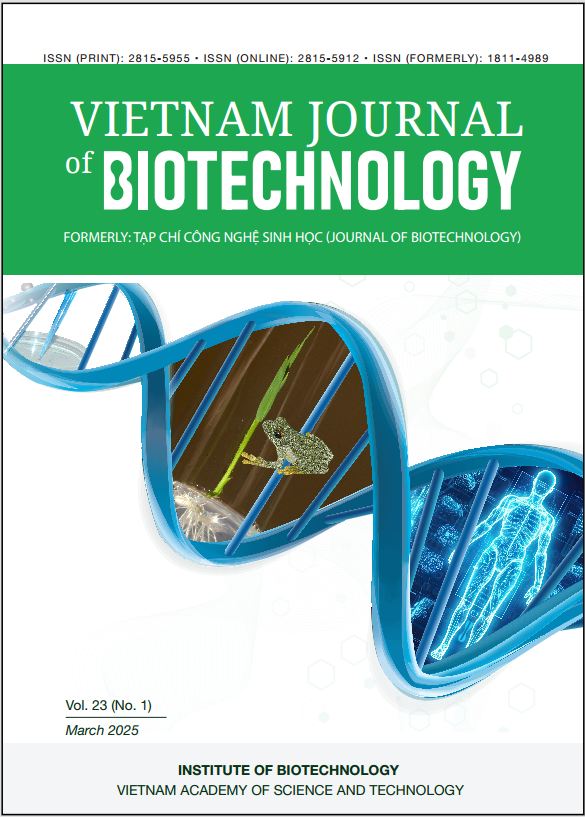Insights into antimicrobial resistance genotype and potential virulent traits of an extensively drug-resistant Acinetobacter baumannii sequence type ST2
Author affiliations
DOI:
https://doi.org/10.15625/vjbt-21792Keywords:
Acinetobacter baumannii, extensively drug resistance, antibiotic-resistant genes, sequence type ST2, virulence genesAbstract
Carbapenem-resistant Acinetobacter baumannii has been ranked as the priority 1 pathogen and is urgently needed for the development of new antimicrobials. Understanding the genetic determinants associated with antibiotic resistance and virulence can help to control the resistant evolution, decide on treatment and have appropriate prevention methods. The present study aimed to characterize the genomic features of an extensively drug-resistant (XDR) A. baumannii sequence type ST2. Phenotypic-drug susceptibility testing was conducted against 28 antibiotics. Whole genome sequencing was performed, followed by an analysis of Clusters of Orthologous Genes (COG), Kyoto Encyclopedia of Genes and Genomes (KEGG) pathways, multilocus sequence typing (MLST), genetic determinants associated with resistance and virulence, and mobile genetic elements. A. baumannii VD610 was resistant to 26 antibiotics and identified as an extensively antibiotic-resistant phenotype. The genome size of A. baumannii VD610 was 3,765,945 bp, comprising a circular chromosome and two plasmids. The COG annotation identified 3012 genes that could be classified into 22 functional categories. There were 1644 genes mapped to the KEGG pathways. This strain was assigned to the sequence type ST2 by the Pasteur MLST scheme, and harbored 32 antibiotic-resistant genes responsible for aminoglycosides, β-lactams, quinolones, phenicols, tetracyclines, fosfomycins, antifolates, erythromycin, and streptogramin resistance, in which blaOXA-23 and blaOXA-66 are responsible for carbapenem resistance. The virulome of A. baumannii VD610 consists of 36 virulence genes which are crucial for its pathogenicity. Our findings provide the genetic features of Vietnamese XDR A. baumannii sequence type ST2, which can be a reference for further study.
Downloads
References
Anand. S. & Srivastava, P. (2020). Optimization Strategies for Purification of Mycophenolic Acid Produced by Penicillium brevicompactum. Applied Biochemistry and Biotechnology, 191(2), 867–880. https://doi.org/10.1007/s12010-019-03204-w
Bentley, R. (2000). Mycophenolic acid: A one-hundred-year odyssey from antibiotic to mmunosuppressant. Chemical Reviews, 100(10), 3801–3825. https://doi.org/10.1021/cr990097b
Dong, C-H., Xie, X-Q., Wang, X-L., Zhan, Y. & Yao, Y-J. (2009). Application of Box-Behnken design in optimisation for polysaccharides extraction from cultured mycelium of Cordyceps sinensis. Food and Bioproducts Processing, 87(2), 139–144. https://doi.org/10.1016/j.fbp.2008.06.004
Dong, Y., Xu, R., Wang, L., Zhang, J., Bai, C., Sun et al. (2015). A combined feeding strategy for enhancing mycophenolic acid production by fed-batch fermentation in Penicillium brevicompactum. Process Biochemistry, 50, 336–340. https://doi.org/10.1007/s12010-022-03886-9
Elbarbry, F.A. & Shoker, A.S. (2007). Liquid chromatographic determination of mycophenolic acid and its metabolites in human kidney transplant plasma: Pharmacokinetic application. Journal of Chromatography B, 859(2), 276–281. https://doi.org/10.1016/j.jchromb.2007.09.036
Ferreira, P.C.L., Thiesen, F.V., Pereira, A.G., Zimmer, A.R., Fröehlich, P.E. (2020). A short overview on mycophenolic acid pharmacology and pharmacokinetics. Clinical Transplantation, 34: e13997. https://doi.org/10.1111/ctr.13997
Frisvad, J.C. (1981). Physiological criteria and mycotoxin production as aids in identification of common asymmetric penicillia. Applied and Environmental Microbiology, 41, 568–579. https://doi.org/10.1128/aem.41.3.568-579.1981
Ismaiel, A.A., Ahmed, A.S. & El-Sayed, E-SR. (2014). Optimization of submerged fermentation conditions for immunosuppressant mycophenolic acid production by Penicillium roqueforti isolated from blue-molded cheeses: Enhanced production by ultraviolet and gamma irradiation. World Journal of Microbiology Biotechnology, 30(10), 2625–2638. https://doi.org/10.1007/s11274-014-1685-1
Patel, G., Patil, M.D., Soni, S., Khobragade, T.P., Chisti, Y. & Banerjee, U.C. (2016). Production of mycophenolic acid by Penicillium brevicompactum—A comparison of two methods of optimization. Biotechnology Reports (Amts), 11, 77–85. https://doi.org/10.1016/j.btre.2016.07.003
Ramos-Ponce, L.M., Contreras-Esquivel, J.C., Saenz, J.M., Lara-Cisneros, G. & Garza-Garcia, Y. (2012). Study on production of mycophenolic acid by Penicillium pinophilum using response surface metodology. 2012 IEEE 2nd Portuguese Meeting in Bioengineering (ENBENG). https://doi.org/10.1109/enbeng.2012.6331348
Regueira, T.B., Kildegaard, K.R., Hansen, B.G., Mortensen, U.H., Hertweck, C. & Nielsen, J. (2011). Molecular basis for mycophenolic acid biosynthesis in Penicillium brevicompactum. Applied and Environmental Microbiology, 77(9), 3035–3043. https://doi.org/10.1128/aem.03015-10
Zhang, W., Du, L., Qu, Z., Zhang, X., Li, F., Li, et al. (2019). Compartmentalized biosynthesis of mycophenolic acid. Proceedings of the National Academy of Sciences, 16(27), 13305-13310.







